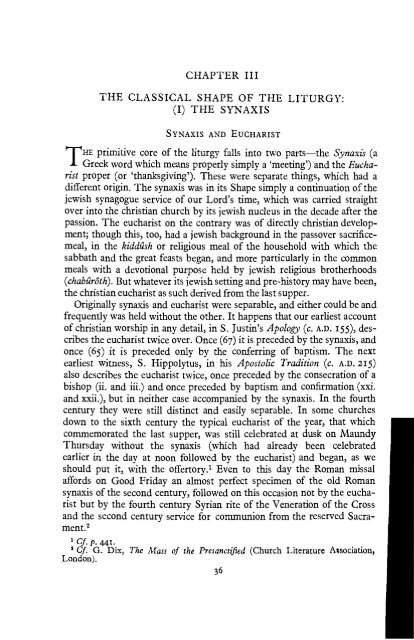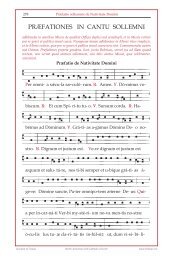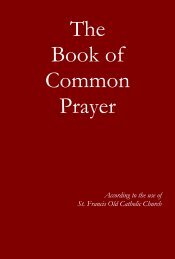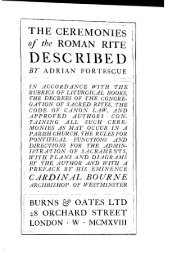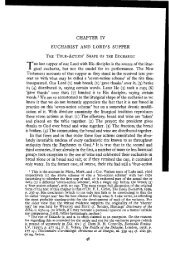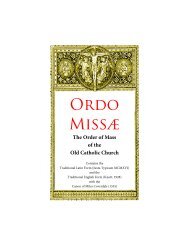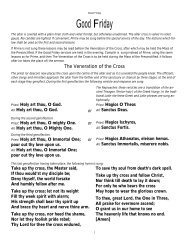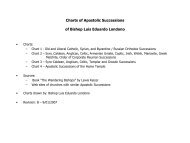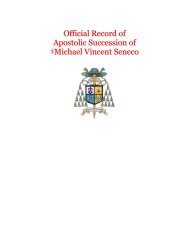The Shape of the Liturgy; Chapter III
The Shape of the Liturgy; Chapter III
The Shape of the Liturgy; Chapter III
Create successful ePaper yourself
Turn your PDF publications into a flip-book with our unique Google optimized e-Paper software.
CHAPTER <strong>III</strong><br />
THE CLASSICAL SHAPE OF THE LITURGY:<br />
(I) THE SYNAXIS<br />
SYNAXIS AND EUCHARIST<br />
HE primitive core <strong>of</strong> <strong>the</strong> liturgy falls into two parts-<strong>the</strong> Synaxis (a<br />
T Greek word which means properly simply a 'meeting') and <strong>the</strong> Eucharist<br />
proper (or 'thanksgiving'). <strong>The</strong>se were separate things, which had a<br />
different origin. <strong>The</strong> synaxis was in its <strong>Shape</strong> simply a continuation <strong>of</strong> <strong>the</strong><br />
jewish synagogue service <strong>of</strong> our Lord's time, which was carried straight<br />
over into <strong>the</strong> christian church by its jewish nucleus in <strong>the</strong> decade after <strong>the</strong><br />
passion. <strong>The</strong> eucharist on <strong>the</strong> contrary was <strong>of</strong> directly christian development;<br />
though this, too, had a jewish background in <strong>the</strong> passover sacrificemeal,<br />
in <strong>the</strong> kiddush or religious meal <strong>of</strong> <strong>the</strong> household with which <strong>the</strong><br />
sabbath and <strong>the</strong> great feasts began, and more particularly in <strong>the</strong> common<br />
meals with a devotional purpose held by jewish religious bro<strong>the</strong>rhoods<br />
(chabur8th). But whatever its jewishsetting and pre-history may have been,<br />
<strong>the</strong> christian eucharist as such derived from <strong>the</strong> last supper.<br />
Originally synaxis and eucharist were separable, and ei<strong>the</strong>r could be and<br />
frequently was held without <strong>the</strong> o<strong>the</strong>r. It happens that our earliest account<br />
<strong>of</strong> christian worship in any detail, in S. Justin's Apology (c. A.D. 155), describes<br />
<strong>the</strong> eucharist twice over. Once (67) it is preceded by <strong>the</strong> synaxis, and<br />
once (65) it is preceded only by <strong>the</strong> conferring <strong>of</strong> baptism. <strong>The</strong> next<br />
earliest witness, S. Hippolytus, in his Apostolic Tradition (c. A.D. 215)<br />
also describes <strong>the</strong> eucharist twice, once preceded by <strong>the</strong> consecration <strong>of</strong> a<br />
bishop (ii. and iii.) and once preceded by baptism and confirmation (xxi.<br />
and xxii.), but in nei<strong>the</strong>r case accompanied by <strong>the</strong> synaxis. In <strong>the</strong> fourth<br />
century <strong>the</strong>y were still distinct and easily separable. In some churches<br />
down to <strong>the</strong> sixth century <strong>the</strong> typical eucharist <strong>of</strong> <strong>the</strong> year, that which<br />
commemorated <strong>the</strong> last supper, was still celebrated at dusk on Maundy<br />
Thursday without <strong>the</strong> synaxis (which had already been celebrated<br />
earlier in <strong>the</strong> day at noon followed by <strong>the</strong> eucharist) and began, as we<br />
should put it, with <strong>the</strong> <strong>of</strong>fertory.! Even to this day <strong>the</strong> Roman missal<br />
affords on Good Friday an almost perfect specimen <strong>of</strong> <strong>the</strong> old Roman<br />
synaxis <strong>of</strong> <strong>the</strong> second century, followed on this occasion not by <strong>the</strong> eucharist<br />
but by <strong>the</strong> fourth century Syrian rite <strong>of</strong> <strong>the</strong> Veneration <strong>of</strong> <strong>the</strong> Cross<br />
and <strong>the</strong> second century service for communion from <strong>the</strong> reserved Sacrament.<br />
2<br />
1 C/.p. 441.<br />
I C/. G. Dix, <strong>The</strong> Mass <strong>of</strong> <strong>the</strong> Presanctified (Church Literature A$sociation,<br />
London).
THE CLASSICAL SHAPE: THE SYNAXIS 37<br />
However, despite <strong>the</strong>ir separate origin and different purpose, <strong>the</strong> synaxis<br />
normallypreceded <strong>the</strong> eucharist in <strong>the</strong> regular Sundayworship<strong>of</strong>allchurches<br />
in <strong>the</strong> second century. From <strong>the</strong> fourth century onwards <strong>the</strong> two were<br />
gradually fused, until <strong>the</strong>y came everywhere to be considered inseparable<br />
parts <strong>of</strong> a single rite. We shall find that both <strong>the</strong>ir original distinction and<br />
<strong>the</strong>ir later fusion had at <strong>the</strong> time a true appropriateness to <strong>the</strong> contemporary<br />
situation and mission <strong>of</strong> <strong>the</strong> church in <strong>the</strong> world. Never<strong>the</strong>less, each part<br />
always retained <strong>the</strong> essentials <strong>of</strong> its own character, though less distinctly<br />
in <strong>the</strong> East than in <strong>the</strong> West. Thus it comes about that all over christendom<br />
<strong>the</strong> first part <strong>of</strong> <strong>the</strong> eucharistic action still revolves around <strong>the</strong> book <strong>of</strong> <strong>the</strong><br />
scriptures! and not around <strong>the</strong> chalice and paten at all. Historically this<br />
still testifies to <strong>the</strong> purely jewish pre-christian origin <strong>of</strong> this part <strong>of</strong> <strong>the</strong><br />
rite, though we shall find that <strong>the</strong>re is a deeper reason than mere historical<br />
conservatism. Even so late a composition as <strong>the</strong> English Prayer Book <strong>of</strong><br />
1662 still never mentions holy communion at all until half <strong>the</strong> service<br />
which it calls '<strong>The</strong> Administration <strong>of</strong> Holy Communion' is over, yet few<br />
communicants ask <strong>the</strong>mselves why so strange a thing should be. But such<br />
is <strong>the</strong> force <strong>of</strong> unconscious liturgical tradition, even where it has suffered<br />
so considerable a disturbance as that involved in <strong>the</strong> recasting <strong>of</strong> our<br />
liturgy at <strong>the</strong> Reformation.<br />
<strong>The</strong> Synaxis, or <strong>Liturgy</strong> <strong>of</strong> <strong>the</strong> Spirit<br />
<strong>The</strong> jewish synagogue service, which was <strong>the</strong> root from which <strong>the</strong> apostolic<br />
synaxis sprang, consisted <strong>of</strong> public readings from <strong>the</strong> scripture, <strong>the</strong><br />
singing <strong>of</strong> psalms, a sermon and a number <strong>of</strong> set prayers. Rabbinic scholars<br />
are in disagreement as to whe<strong>the</strong>r <strong>the</strong> prayers came first or last in <strong>the</strong><br />
synagogue<strong>of</strong> <strong>the</strong> first century A.D., and <strong>the</strong>re is no direct evidencefrom that<br />
period as to what prayers were in use, though some extant jewish forms<br />
probably go back to this date. In <strong>the</strong> third century <strong>the</strong> jews undoubtedly<br />
placed <strong>the</strong>m in a group at <strong>the</strong> beginning, and this may have been <strong>the</strong> original<br />
practice <strong>of</strong> <strong>the</strong> synagogue. But in all christian churches from <strong>the</strong> earliest<br />
moment at which we have definite evidence 2 <strong>the</strong> prayers were universally<br />
placed last, after <strong>the</strong> sermon, and have remained <strong>the</strong>re ever since. This was<br />
evidently a fixed christian tradition. Ei<strong>the</strong>r <strong>the</strong> later jewish practice<br />
differed from that usual in <strong>the</strong> jewish circles from which <strong>the</strong> apostolic<br />
church emerged; or conceivably, <strong>the</strong> christians deliberately changed <strong>the</strong><br />
position <strong>of</strong> <strong>the</strong> prayers from motives we shall understand in a moment. If<br />
so, <strong>the</strong> change must have been made early and probably by apostolic<br />
authority, for later christian tradition to be so universal and firm on <strong>the</strong><br />
point.<br />
1 Now bound up for convenience with <strong>the</strong> eucharistic prayers in <strong>the</strong> form <strong>of</strong> a<br />
missal or altar-book in <strong>the</strong> West, but still separate in <strong>the</strong> East.<br />
2 S. Justin, c. A.D. 155, for Rome; <strong>the</strong> Didascalia and Origen in <strong>the</strong> first half <strong>of</strong> <strong>the</strong><br />
third century, for Syria and Egypt.
THE SHAPE OF THE LITURGY<br />
<strong>The</strong> original unchanging outline <strong>of</strong><strong>the</strong> christian synaxis everywhere was<br />
as follows:-<br />
I. Opening greeting by <strong>the</strong> <strong>of</strong>ficiant and reply <strong>of</strong><strong>the</strong> church.<br />
2. Lesson.<br />
3. Psalmody.<br />
4. Lesson (or Lessons, separated by Psalmody).<br />
5. Sermon.<br />
6. Dismissal <strong>of</strong>those who did not belong to <strong>the</strong> church.<br />
7. Prayers.<br />
8. Dismissal <strong>of</strong><strong>the</strong> church.<br />
(9. On occasions a collection for <strong>the</strong> poor, <strong>the</strong> expenses <strong>of</strong><strong>the</strong> church,<br />
etc., was made. But this was ra<strong>the</strong>r a separate duty <strong>of</strong> church life, which<br />
might for convenience be performed at <strong>the</strong> 'meeting', than a part <strong>of</strong> <strong>the</strong><br />
synaxis itself.)<br />
1. Opening Greeting and Reply. This was in a sense only a polite method<br />
<strong>of</strong> 'calling <strong>the</strong> meeting to order' and indicating that proceedings were about<br />
to begin. But <strong>the</strong> 'meeting' was after all one with a religious purpose, and<br />
<strong>the</strong> greeting took a religious form. It is found all over christendom in one<br />
<strong>of</strong> two forms: '<strong>The</strong> Lord be with you', or 'Peace be unto you' (or 'to all').<br />
Both are <strong>of</strong>jewish origin (cf. Ruth ii. 4, John xx. 19) and came into christian<br />
use from <strong>the</strong> beginning. <strong>The</strong> jewish Talmud remarks <strong>of</strong> <strong>the</strong> first that<br />
'It was used <strong>of</strong> old time when a man would recall his companions to remembrance<br />
<strong>of</strong> <strong>the</strong> Law.'l As such it is probably an inheritance from <strong>the</strong><br />
original jewish-christian worship <strong>of</strong> <strong>the</strong> first days <strong>of</strong> christianity, in which<br />
<strong>the</strong> immediately following first lesson would be taken from <strong>the</strong> Law <strong>of</strong><br />
Moses. <strong>The</strong> o<strong>the</strong>r form, 'Peace be unto you', is <strong>the</strong> ordinary oriental greeting<br />
'Salaam' (Heb. Shalom). It had a special and beautiful significance in<br />
christian worship as <strong>the</strong> first greeting <strong>of</strong> <strong>the</strong> Risen Lord to His own (John<br />
xx. 19). By a delicate distinction it later came to be reserved in <strong>the</strong> West<br />
to <strong>the</strong> bishop, as <strong>the</strong> direct personal representative <strong>of</strong>our Lord to his own<br />
church, while <strong>the</strong> presbyter was restricted to <strong>the</strong> less significant form<br />
referring only to <strong>the</strong> lessons about to be read. <strong>The</strong> reply <strong>of</strong> <strong>the</strong> church,<br />
'And with thy spirit', suggests by its 'semitic parallelism' that it, too, came<br />
originally from jewish usage, <strong>of</strong> which <strong>the</strong>re may be an echo in 2 Tim.<br />
iv. 22. But it was interpreted by christians as an acknowledgement<br />
<strong>of</strong> <strong>the</strong> special grace <strong>of</strong> <strong>the</strong> Holy Ghost received by <strong>the</strong> celebrant at<br />
his ordination for his ministry2, which at <strong>the</strong> synaxis was to proclaim<br />
and interpret <strong>the</strong> Word <strong>of</strong> God set forth in <strong>the</strong> scriptures now about to be<br />
read.<br />
1 Tractate Berakoth, Tos. vii. 23.<br />
2 Cf. e.g., <strong>The</strong>odore <strong>of</strong> Mopsuestia (Asia Minor c. A. D. 400) Catecheses vi. ed.<br />
Ming~na, p. 91. <strong>The</strong> use <strong>of</strong> '<strong>The</strong> Lord be with you' is still <strong>of</strong>ficially restricted to<br />
those m holy orders. It may be suggested that it was <strong>the</strong> inappropriateness <strong>of</strong> <strong>the</strong><br />
reply, interpreted in this sense, to those not ordained, which originally suggested<br />
<strong>the</strong> prohibition <strong>of</strong> <strong>the</strong>ir using <strong>the</strong> greeting.
THE CLASSICAL SHAPE: THE SYNAXIS 39<br />
2, 3 and 4. <strong>The</strong> Lessons and Psalmody.<strong>The</strong> jewishpractice wasto read first<br />
from <strong>the</strong> Law <strong>of</strong> Moses as <strong>the</strong> most revered <strong>of</strong> <strong>the</strong>ir scriptures, and <strong>the</strong>n,<br />
after psalmody, one or more lessons from <strong>the</strong> Prophets or o<strong>the</strong>r books. <strong>The</strong><br />
christians came to adopt an ascending instead <strong>of</strong> a descending order <strong>of</strong><br />
importance in <strong>the</strong> reading <strong>of</strong> <strong>the</strong> lessons,! which was also rougWy <strong>the</strong><br />
chronological order <strong>of</strong> <strong>the</strong>ir original writing. <strong>The</strong> christians read first one<br />
or more lessons from <strong>the</strong> Old Testament,2 <strong>the</strong>n from <strong>the</strong> apostolic writings,<br />
and finally from <strong>the</strong> gospel which records our Lord's own sayings and<br />
doings. <strong>The</strong> 'Word <strong>of</strong> <strong>the</strong> Lord' finds its completeness in <strong>the</strong> 'Word made<br />
Flesh.' In large ga<strong>the</strong>rings at least, ifnot always, <strong>the</strong> lessons were chanted<br />
to a simple inflection ra<strong>the</strong>r than read. This was partly in order to secure<br />
that <strong>the</strong>y should be heard distinctly, and partly to give <strong>the</strong>m solemnity as<br />
<strong>the</strong> Word <strong>of</strong> God to <strong>the</strong> church, and through <strong>the</strong> church to <strong>the</strong> world.<br />
This custom also had been known in <strong>the</strong> jewish synagogues, even ifit was<br />
not necessarily alwaysobserved in small country places.<br />
Between <strong>the</strong> lessons came <strong>the</strong> singing <strong>of</strong> psalms or o<strong>the</strong>r canticles from<br />
scripture (a chant known in later times as <strong>the</strong> 'gradual' from its being<br />
sung by tlle soloists from <strong>the</strong> 'steps' <strong>of</strong> <strong>the</strong> raised lectern), a custom which<br />
must have been familiar to our Lord and His apostles, since it was universal<br />
in <strong>the</strong> synagogues <strong>of</strong> <strong>the</strong>ir day. It served as a relief for <strong>the</strong> attention <strong>of</strong><br />
<strong>the</strong> hearers. But it also <strong>of</strong>fered <strong>the</strong> opportunity by intelligent selection for a<br />
devotional comment on <strong>the</strong> scripture just read which would bring home<br />
its point to <strong>the</strong> minds and hearts <strong>of</strong> <strong>the</strong> hearers. Such rare examples as we<br />
have <strong>of</strong> really early 'comment' in this way by <strong>the</strong> chant on <strong>the</strong> lesson show<br />
an apt and ingenious understanding <strong>of</strong> <strong>the</strong> devotional use <strong>of</strong> <strong>the</strong> scriptures. 3<br />
Dignity and attractiveness were given to this musical side <strong>of</strong> <strong>the</strong> service by<br />
entrusting much <strong>of</strong> it to special singers who sang elaborate solos. But <strong>the</strong><br />
corporate nature <strong>of</strong> <strong>the</strong> rite was not lost sight <strong>of</strong>, and a part was usually<br />
reserved for <strong>the</strong> whole congregation to join as chorus in a simple refrain.<br />
Until <strong>the</strong> fourth century <strong>the</strong> psalmody appears always to have been in this<br />
form in <strong>the</strong> church, elaborate solo and simple chorus, and never, as it is<br />
usually with us, by two alternating choruses. <strong>The</strong> earlier christian form<br />
was that which had been employed in <strong>the</strong> synagogue, where <strong>the</strong> signal for<br />
1 Justin, Apol., i. 67 suggests that this had not yet been adopted when he wrote<br />
C.A.D.I55·<br />
2 Among <strong>the</strong> a.T. lessons <strong>the</strong> Law <strong>of</strong> Moses seems for a while to have retained<br />
something <strong>of</strong> its jewish pre-eminence over <strong>the</strong> o<strong>the</strong>r a.T. scriptures in christian<br />
eyes, and <strong>the</strong>refore was read after <strong>the</strong>m in <strong>the</strong> new ascending order. Later <strong>the</strong> church<br />
adopted a purely chronological scheme in reading <strong>the</strong> a.T., placing <strong>the</strong> Law first<br />
and <strong>the</strong> Prophets, etc., after; thus returning to <strong>the</strong> jewish order, though for a<br />
different reason. So on Good Friday, <strong>the</strong> Roman rite, which retains for this day a<br />
second century form <strong>of</strong> synaxis, reads Hosea before Exodus. But on Holy Saturday,<br />
<strong>the</strong> lessons <strong>of</strong> which were arranged in <strong>the</strong> fourth century, <strong>the</strong> Law is read before <strong>the</strong><br />
Prophets. <strong>The</strong>re are now many different strata in <strong>the</strong> liturgical cycle, <strong>the</strong> product <strong>of</strong><br />
2,000 years <strong>of</strong> history, and each <strong>of</strong> <strong>the</strong>m has its own characteristics.<br />
• E.g. <strong>the</strong> use <strong>of</strong> 1's. xc. 1-I2 as a comment on Hos. vi. at <strong>the</strong> paschal vigil, which<br />
was <strong>the</strong> Roman use in <strong>the</strong> third and probably in <strong>the</strong> second century.
4° THE SHAPE OF THE LITURGY<br />
<strong>the</strong> people's refrain was <strong>the</strong> cantor's cry 'Hallelujah', whence <strong>the</strong> 'Alleluias'<br />
still found in <strong>the</strong> gradual at <strong>the</strong> liturgy. <strong>The</strong> method <strong>of</strong> psalmody to<br />
which we are accustomed may have been used in <strong>the</strong> jewish temple, but it<br />
did not come into christian use apparently until A.D. 347-48, when it began<br />
to be employed by a confraternity <strong>of</strong> laymen at Antioch, and from <strong>the</strong>re<br />
spread rapidly over christendom.! <strong>The</strong> use <strong>of</strong> <strong>the</strong> psalter 'in course' (i.e.<br />
right through in regular order, and not as selected psalms to comment on<br />
o<strong>the</strong>r scriptures) in christian services is one <strong>of</strong> <strong>the</strong> by-products <strong>of</strong> <strong>the</strong><br />
monastic movement <strong>of</strong> <strong>the</strong> fourth century.<br />
5. <strong>The</strong> Sermon. <strong>The</strong> delivery <strong>of</strong> <strong>the</strong> sermon was as much <strong>the</strong> bishop's<br />
'special liturgy' and proper function at <strong>the</strong> synaxis as <strong>the</strong> <strong>of</strong>fering <strong>of</strong> <strong>the</strong><br />
eucharistic prayer was his 'special liturgy' at <strong>the</strong> eucharist. As we have<br />
seen, <strong>the</strong> bishop at his consecration received a special 'gift <strong>of</strong> grace'<br />
(charisma) for <strong>the</strong> <strong>of</strong>fice 2 not only <strong>of</strong> high-priest <strong>of</strong> <strong>the</strong> church's prayers and<br />
<strong>of</strong>ferings, but also <strong>of</strong> quasi-inspired 'prophetic teacher'3 <strong>of</strong> <strong>the</strong> church's<br />
faith. He is <strong>the</strong> church's mouthpiece, as it were, towards man as well as<br />
towards God. Except in emergencies, <strong>the</strong>refore, he was irreplaceable as<br />
preacher at <strong>the</strong> synaxis, <strong>the</strong> solemn corporate 'church', even by <strong>the</strong> ablest<br />
<strong>of</strong> his presbyters. <strong>The</strong> great Origen himselfgave great scandal in <strong>the</strong> third<br />
century by presuming to preach as a presbyter at <strong>the</strong> synaxis at Caesarea,<br />
though he did so at <strong>the</strong> invitation <strong>of</strong> <strong>the</strong> local bishop. And <strong>the</strong> feeling died<br />
hard. At <strong>the</strong> end <strong>of</strong> <strong>the</strong> fourth century <strong>the</strong> people <strong>of</strong> Hippo objected to<br />
<strong>the</strong>ir aged bishop's delegation <strong>of</strong> <strong>the</strong> sermon at <strong>the</strong> synaxis even to that<br />
prince <strong>of</strong> popular preachers, S. Augustine. It was <strong>the</strong> 'special liturgy' <strong>of</strong><br />
<strong>the</strong> bishop's 'order', without which <strong>the</strong> action <strong>of</strong> <strong>the</strong> whole church in its<br />
synaxis was felt to be incomplete. <strong>The</strong> presbyters and o<strong>the</strong>r christian<br />
teachers might expound <strong>the</strong>ir ideas at o<strong>the</strong>r ga<strong>the</strong>rings to as many as would<br />
hear <strong>the</strong>m, but <strong>the</strong> synaxis had a different character from even <strong>the</strong> largest<br />
private ga<strong>the</strong>ring <strong>of</strong> christians. It was <strong>the</strong> solemn corporate witness <strong>of</strong> <strong>the</strong><br />
whole church to <strong>the</strong> revelation <strong>of</strong> God recorded in <strong>the</strong> scriptures. At this<br />
<strong>the</strong> bishop, and <strong>the</strong> bishop only, must expound <strong>the</strong> corporate faith which<br />
his local church shared with <strong>the</strong> whole catholic church and <strong>the</strong> whole<br />
christian past, back to <strong>the</strong> apostles <strong>the</strong>mselves. It was this, <strong>the</strong> unchanging<br />
'saving' truth <strong>of</strong> <strong>the</strong> gospel, and not any personal opinion <strong>of</strong> his own,<br />
which he must proclaim in <strong>the</strong> liturgical sermon, because he alone was<br />
endowed by <strong>the</strong> power <strong>of</strong> <strong>the</strong> Spirit with <strong>the</strong> '<strong>of</strong>fice' <strong>of</strong> speaking <strong>the</strong><br />
au<strong>the</strong>ntic mind <strong>of</strong> his church.<br />
<strong>The</strong>re is a passage <strong>of</strong> S. Irenaeus which sheds so much light on <strong>the</strong> conception<br />
<strong>of</strong> <strong>the</strong> liturgical sermon in <strong>the</strong> second century that it is worth<br />
quoting here, despite its length:<br />
'Having received this <strong>of</strong>fice <strong>of</strong> proclamation and this faith aforesaid, <strong>the</strong><br />
I Cf. p. 328. 2 Rom. 12.5.<br />
3 So <strong>the</strong> christians <strong>of</strong> Smyrna describe <strong>the</strong>ir late bishop Polycarp, <strong>the</strong> disciple <strong>of</strong><br />
S. John, in A.D. 156 (Mart. Pol. 16).
THE CLASSICAL SHAPE: THE SYNAXIS 41<br />
church, though she be spread abroad over all <strong>the</strong> earth, diligently observes<br />
<strong>the</strong>m as dwelling in a single household; and she unanimously believes<br />
<strong>the</strong>se things, as having one soul and <strong>the</strong> same heart; and she concordantly<br />
proclaims and teaches and hands down <strong>the</strong>se things, as having but one<br />
mouth. For, though <strong>the</strong> tongues <strong>of</strong> earthly speech differ, yet is <strong>the</strong> force <strong>of</strong><br />
tradition ever one and <strong>the</strong> same. And <strong>the</strong> churches which have been planted<br />
in <strong>the</strong> Germanies have received no different faith and taught no o<strong>the</strong>rwise,<br />
nor those in Spain, nor those among <strong>the</strong> Gauls, nor those in <strong>the</strong> East, nor<br />
those in Egypt, nor those in Libya, nor those that are in <strong>the</strong> centre <strong>of</strong> <strong>the</strong><br />
world (Italy). But as <strong>the</strong> sun, God's creature, is one and <strong>the</strong> same for<br />
all <strong>the</strong> world, so does <strong>the</strong> proclamation <strong>of</strong> <strong>the</strong> truth everywhere shine and<br />
enlighten all men who are willing to come to <strong>the</strong> knowledge <strong>of</strong> <strong>the</strong> truth.<br />
And as among those who preside over <strong>the</strong> churches he who is very skilled<br />
in teaching says nothing else than this-for no man is above his own<br />
teacher-so he who is but a poor teacher yet does not omit <strong>the</strong> contents<br />
<strong>of</strong> <strong>the</strong> tradition. For since <strong>the</strong>ir faith is one and <strong>the</strong> same, nei<strong>the</strong>r does<br />
he who can say a great deal about it actually add to it, nor does he who can<br />
say but little diminish it.'!<br />
It was this 'tradition' <strong>of</strong> faith, <strong>the</strong> unchanging revelation shared by all<br />
generations <strong>of</strong> christians alike, which <strong>the</strong> bishop proclaimed in his sermon,<br />
basing himself on <strong>the</strong> scriptures just read. He preaches <strong>the</strong>refore, in his<br />
<strong>of</strong>ficial capacity, sitting upon <strong>the</strong> throne behind <strong>the</strong> altar which was his<br />
'teacher's chair', as <strong>the</strong> representative <strong>of</strong> God revealing Himself to <strong>the</strong><br />
world.<br />
6, 7 and 8. <strong>The</strong> Dismissals and Prayers. Thus far <strong>the</strong> synaxis had been<br />
in fact what it was in name, a 'public meeting', open to all who wished<br />
to attend, jews,pagans, enquirers <strong>of</strong> all kinds, as well as to <strong>the</strong> catechumens<br />
preparing to be received into <strong>the</strong> church by baptism and confirmation.<br />
<strong>The</strong> church had a corporate duty to preach <strong>the</strong> gospel to <strong>the</strong> world and<br />
to witness to its truth. But prayer was ano<strong>the</strong>r matter. Thus far <strong>the</strong>re<br />
had been no prayer <strong>of</strong> any kind, but only instruction.<br />
<strong>The</strong> church is <strong>the</strong> Body <strong>of</strong> Christ and prays 'in <strong>the</strong> name' <strong>of</strong> Jesus, 2 i.e.<br />
according to <strong>the</strong> semitic idiom which underlies <strong>the</strong> phrase, 'in His Person.'<br />
'<strong>The</strong> Spirit <strong>of</strong> adoption whereby' <strong>the</strong> church cries to God in Christ's<br />
Name, 'Abba, Fa<strong>the</strong>r'3 with <strong>the</strong> certainty <strong>of</strong> being heard, 'Himself makes<br />
intercession'4 with her in her prayers. <strong>The</strong> world had a right to hear <strong>the</strong><br />
gospel; but those who have not yet 'put on Christ' by baptism 5 and thus<br />
as 'sons' received His Spirit by confirmation 6 cannot join in <strong>of</strong>fering that<br />
prevailing prayer. All who had not entered <strong>the</strong> order <strong>of</strong> <strong>the</strong> laity were<br />
<strong>the</strong>refore without exception turned out <strong>of</strong> <strong>the</strong> assembly after <strong>the</strong> sermon.<br />
1 Adv. Haer. I. x. 2. S. Irenaeus, disciple <strong>of</strong> Polycarp, <strong>the</strong> disciple <strong>of</strong> S. John,<br />
was bishop <strong>of</strong> Lyons C. A.D. 180-200.<br />
• John xiv. 13. • Rom. viii. 15. 4 Rom. viii. 26. 6 Gal. iii. 27.<br />
• Gal. iv. 6.
THE SHAPE OF THE LITURGY<br />
<strong>The</strong> catechumens who had accepted <strong>the</strong> faith, but had not yet been added<br />
to <strong>the</strong> church by <strong>the</strong> sacraments, first received a special blessing from <strong>the</strong><br />
bishop..<strong>The</strong> following text <strong>of</strong> this, from Egypt in <strong>the</strong> fourth century, is<br />
<strong>the</strong> earltest we possess, and probably goes back considerably behind <strong>the</strong><br />
date <strong>of</strong> S. Sarapion (c. A.D. 340) under whose name it has come down to us.<br />
<strong>The</strong> deacons first proclaimed loudly: 'Bow down your heads for a blessing,<br />
o ye catechumens', and <strong>the</strong>n <strong>the</strong> bishop raising his hand in <strong>the</strong> sign <strong>of</strong><strong>the</strong><br />
cross blessed <strong>the</strong>m: 'We raise our hand, 0 Lord, and pray that <strong>the</strong> divine<br />
and lifegiving Hand be raised for a blessing unto this people;! for unto<br />
<strong>The</strong>e, eternal Fa<strong>the</strong>r, have <strong>the</strong>y bowed <strong>the</strong>ir heads through Thine only<br />
begotten Son. Bless this people unto <strong>the</strong> blessing <strong>of</strong> knowledge and<br />
piety, unto <strong>the</strong> blessing <strong>of</strong> Thy mysteries; through Thy only-begotten Son<br />
Jesus Christ, by Whom glory and might be unto <strong>The</strong>e in <strong>the</strong> Holy Ghost<br />
now and throughout ail ages. Amen.'<br />
<strong>The</strong> deacons now proclaimed: 'Let <strong>the</strong> catechumens depart. Let no<br />
catechumen remain. Let <strong>the</strong> catechumens go forth'; and when <strong>the</strong>se had<br />
gone, cried again: '<strong>The</strong> doors! <strong>The</strong> doors!' as a signal to those <strong>of</strong> <strong>the</strong>ir<br />
number, or <strong>the</strong>ir assistants, who guarded <strong>the</strong> doors, to close and lock <strong>the</strong>m<br />
against all intrusion. <strong>The</strong>n <strong>the</strong> church corporately fell to prayer.<br />
First a subject was announced, ei<strong>the</strong>r by <strong>the</strong> <strong>of</strong>ficiant (in <strong>the</strong> West) or<br />
<strong>the</strong> chief deacon (in <strong>the</strong> East), and <strong>the</strong> congregation was bidden to pray.<br />
All prayed silently on <strong>the</strong>ir knees for a while; <strong>the</strong>n, on <strong>the</strong> signal being<br />
given, <strong>the</strong>y rose from <strong>the</strong>ir knees, and <strong>the</strong> <strong>of</strong>ficiantsummed up <strong>the</strong> petitions<br />
<strong>of</strong> 211 in a briefcollect. <strong>The</strong>y knelt to pray as individuals, but <strong>the</strong> corporate<br />
prayer <strong>of</strong> <strong>the</strong> church is a priestly act, to be done in <strong>the</strong> priestly posture for<br />
prayer, standing. <strong>The</strong>refore all, not <strong>the</strong> celebrant only, rose for <strong>the</strong> concluding<br />
collect.<br />
<strong>The</strong> following is <strong>the</strong> scheme <strong>of</strong> <strong>the</strong> old Roman intercessions still in use<br />
on Good Friday.<br />
'Officiant: Let us pray, my dearly beloved, for <strong>the</strong> holy church <strong>of</strong> God,<br />
that our Lord and God would be pleased to keep her in peace, unity and<br />
safety throughout all <strong>the</strong> world, subjecting unto her principalities and<br />
powers, 2 and grant us to live out <strong>the</strong> days <strong>of</strong> a peaceful and quiet life in<br />
glorifying God <strong>the</strong> Fa<strong>the</strong>r Almighty.<br />
'Deacon: Let us bow <strong>the</strong> knee. (All kneel and pray in silence for a<br />
while.)<br />
'Subdeacon: Arise.<br />
'Officiant: Almighty everlasting God, Who hast revealed Thy glory unto<br />
all nations in Christ, preserve <strong>the</strong> work <strong>of</strong> Thy mercy; that Thy church<br />
which is spread abroad throughout all <strong>the</strong> world may continue with a firm<br />
faith in <strong>the</strong> confession <strong>of</strong> Thy holy Name: through .. .'<br />
<strong>The</strong>re follmv prayers for <strong>the</strong> bishop, <strong>the</strong> clergy, and 'all <strong>the</strong> holy people<br />
1 <strong>The</strong> bishop prays with uplifted hand as representing <strong>the</strong> Fa<strong>the</strong>r here.<br />
, I.e. <strong>the</strong> forces <strong>of</strong> Satan. Rom. viii. 38; Eph. vi. 12.
THE CLASSICAL SHAPE: THE SYNAXIS 43<br />
<strong>of</strong> God';l for <strong>the</strong> government and <strong>the</strong> state; for <strong>the</strong> catechumens; for <strong>the</strong><br />
needs <strong>of</strong> <strong>the</strong> world and all in tribulation (a particularly fine collect, which<br />
has inspired one <strong>of</strong> <strong>the</strong> best <strong>of</strong> <strong>the</strong> <strong>of</strong>ficial Anglican prayers for use in <strong>the</strong><br />
present war); for heretics and schismatics; for <strong>the</strong> jews, and for <strong>the</strong> pagans.<br />
<strong>The</strong>se prayers probably date from <strong>the</strong> fourth and fifth centuries in <strong>the</strong>ir<br />
present form, but may well be only revisions <strong>of</strong> earlier third century forms.<br />
Or we may take an Eastern scheme from <strong>the</strong> Alexandrian liturgy, probably<br />
<strong>of</strong> much <strong>the</strong> same date as <strong>the</strong>se Roman prayers. 2<br />
'<strong>The</strong> deacon proclaims first: Stand to pray. (All have been 'standing at<br />
ease' or sitting on <strong>the</strong> ground for <strong>the</strong> sermon.)<br />
'<strong>The</strong>n he begins: Pray for <strong>the</strong> living; pray for <strong>the</strong> sick; pray for all away<br />
from home.<br />
'Let us bow <strong>the</strong> knee. (All pray in silence.) Let us arise. Let us bow <strong>the</strong><br />
knee. Let us arise again. Let us bow <strong>the</strong> knee.<br />
'<strong>The</strong> people: Lord have mercy.'<br />
(<strong>The</strong> <strong>of</strong>ficiant's prayers in <strong>the</strong>ir original form have been lost in this<br />
section <strong>of</strong> <strong>the</strong> intercessions;3 but <strong>the</strong> deacon's proclamations continue:)<br />
'Pray for fair winds and <strong>the</strong> fruits <strong>of</strong> <strong>the</strong> earth; pray for <strong>the</strong> due rising <strong>of</strong><br />
<strong>the</strong> waters <strong>of</strong> <strong>the</strong> river; pray for good showers and <strong>the</strong> harvest <strong>of</strong> <strong>the</strong> land. 4<br />
Let us bow <strong>the</strong> knee, etc.<br />
'Pray for <strong>the</strong> safety <strong>of</strong> men and beasts; pray for <strong>the</strong> safety <strong>of</strong> <strong>the</strong> world<br />
and <strong>of</strong> this city; pray for our most christian emperors. Let us bow, etc.<br />
'Pray for all in captivity; pray for those that are fallen asleep; pray for<br />
<strong>the</strong>m that <strong>of</strong>fer this our sacrifice (i.e. for <strong>the</strong>ir intentions); pray for all that<br />
are in affliction; pray for <strong>the</strong> catechumens. Pray! Let us bow,' etc.<br />
<strong>The</strong> text has also been preserved <strong>of</strong> what appears to be substantially an<br />
even older set <strong>of</strong> Alexandrian intercessions, now known as '<strong>The</strong> three great<br />
prayers', which now follow this diaconallitany and are still used at several<br />
points in <strong>the</strong> Coptic rite. Itruns as follows:<br />
'Deacon: Pray for <strong>the</strong> peace <strong>of</strong> <strong>the</strong> one holy catholic and apostolic orthodox<br />
church <strong>of</strong> God. (<strong>The</strong> people prostrate and say: Lord have mercy.)<br />
'Officiant: We pray and beseech Thy goodness, 0 Lover <strong>of</strong> mankind:<br />
remember, 0 Lord, <strong>the</strong> peace <strong>of</strong> Thy one holy catholic and apostolic<br />
church which is from one end <strong>of</strong> <strong>the</strong> world to <strong>the</strong> o<strong>the</strong>r: bless all <strong>the</strong><br />
peoples and all <strong>the</strong> lands: <strong>the</strong> peace that is from heaven grant in all our<br />
hearts, but also graciously bestow upon us <strong>the</strong> peace <strong>of</strong> this life. <strong>The</strong><br />
emperor, <strong>the</strong> armies, <strong>the</strong> magistrates, <strong>the</strong> councillors, <strong>the</strong> people, our<br />
1 This prayer is interesting as still recognising <strong>the</strong> laity as an 'order': 'Almighty<br />
everlasting God by whose Spirit <strong>the</strong> whole body <strong>of</strong> Thy Church is governed and<br />
sanctified; hear us as we pray for all its orders (pro universisordinibus), that by <strong>the</strong><br />
gift <strong>of</strong> Thy grace Thou mayest be faithfully served by all its ranks (omnibus gradibus1.'<br />
2 Brightman, LiturgiesEastern and Western, 1896, p. 158 sq.<br />
• A much expanded later version <strong>of</strong> <strong>the</strong>m will be found L.E.W., p. 166.<br />
4 <strong>The</strong>se petitions reflect <strong>the</strong> local needs <strong>of</strong> Egypt, where winds from <strong>the</strong> desert<br />
may bring sandstorms fatal to <strong>the</strong> crops, and all life depends on <strong>the</strong> annual rising <strong>of</strong><br />
<strong>the</strong> waters <strong>of</strong> <strong>the</strong> Nile.
44 THE SHAPE OF THE LITURGY<br />
neighbours, our comings in and our goings out, order <strong>the</strong>m all in Thy<br />
peace. 0 King <strong>of</strong> peace, grant us peace, for Thou hast given us all things:<br />
possess us, 0 God, for beside <strong>The</strong>e we know none o<strong>the</strong>r: we make mention<br />
<strong>of</strong> Thine holy Name. Let all our souls live through Thine Holy Spirit, and<br />
let not <strong>the</strong> death <strong>of</strong> sin have dominion over us nor all Thy people; through,<br />
etc.<br />
'Deacon: Pray for our Patriarch, <strong>the</strong> Pope and Fa<strong>the</strong>r N., Lord Archbishop<br />
<strong>of</strong> <strong>the</strong> great city <strong>of</strong> Alexandria. (<strong>The</strong> people prostrate and say: Lord<br />
have mercy.)<br />
'Officiant: We pray and beseech Thy goodness, 0 Lover <strong>of</strong> mankind:<br />
remember, 0 Lord, our Patriarch, our honoured Fa<strong>the</strong>r N. Preserve him<br />
to us in safety many years in peaceful times, fulfilling that holy pontificate<br />
which Thou hast Thyself committed unto him according to Thy holy and<br />
blessed will, rightly dividing <strong>the</strong> word <strong>of</strong> truth, feeding Thy people in<br />
holiness and righteousness; and with him all <strong>the</strong> orthodox bishops and<br />
presbyters and deacons, and all <strong>the</strong> fullness <strong>of</strong> Thy one only holy catholic<br />
and apostolic church. Bestow on him with us peace and safety from all<br />
quarters; and his prayers which he maketh on our behalf and on behalf <strong>of</strong><br />
all Thy people (here he shall put on an handful <strong>of</strong>incense) and ours as well<br />
on his behalf, do Thou accept on Thy reasonable altar in heaven for a<br />
sweet-smelling savour. And all his enemies visible and invisible do Thou<br />
bruise and humble shortly under his feet, but himself do Thou keep in<br />
peace and righteousness in Thine holy church.<br />
'Deacon: Pray for this holy assembly (ecclesia) and our meetings. l (<strong>The</strong><br />
people prostrate and say: Lord have mercy.)<br />
'Officiant: We pray and beseech Thy goodness, 0 Lover <strong>of</strong> mankind:<br />
remember, 0 Lord, our congregations. Grant that we may hold <strong>the</strong>m<br />
without hindrance, that <strong>the</strong>y may be held without impediment, according<br />
to Thy holy and blessed will, in houses <strong>of</strong> prayer, houses <strong>of</strong> purity, houses<br />
<strong>of</strong> blessing. Bestow <strong>the</strong>m on us, 0 Lord, and on Thy servants who shall<br />
come after us for ever. Arise, 0 Lord God, and let all Thine enemies be<br />
scattered; let all <strong>the</strong>m that hate Thine holy Name flee from before Thy<br />
face, but let Thy people be in blessings unto thousands <strong>of</strong> thousands and<br />
ten thousand times ten thousand, doing Thy will by <strong>the</strong> grace <strong>of</strong> Thine<br />
only-begotten Son Jesus Christ our Lord; through Whom .. .'<br />
<strong>The</strong>se Egyptian prayers are obviously similar in places to <strong>the</strong> old Roman<br />
prayers we have just glanced at, and <strong>the</strong> general scheme is <strong>the</strong> same. But<br />
this ancient universal scheme has already adapted itself to <strong>the</strong> particular<br />
genius <strong>of</strong> <strong>the</strong> different churches. <strong>The</strong> Roman prayers express exactly <strong>the</strong><br />
old Roman temperament. <strong>The</strong>y are terse, practical and vigorous, expressing<br />
pointedly and precisely what <strong>the</strong>y wish to say without rhetoric or<br />
ornament <strong>of</strong> any kind beyond <strong>the</strong> polish and sonority <strong>of</strong> <strong>the</strong>ir Latin. <strong>The</strong><br />
1 This is <strong>the</strong> ancient distinction between <strong>the</strong> solemn 'assembly' (ecclesia) and <strong>the</strong><br />
private meetings Csyneleuseis),
THE CLASSICAL SHAPE: THE SYNAXIS 45<br />
Egyptian prayers are more 'flowery' in <strong>the</strong>ir devotion, though just as<br />
obviously sincere. <strong>The</strong>y repeat <strong>the</strong>mselves and cite scripture and poetise<br />
<strong>the</strong>ir requests; and one notes that tendency to elaboration for elaboration's<br />
sake (e.g. in <strong>the</strong> triple prostration) which has led to <strong>the</strong> complication <strong>of</strong> all<br />
Eastern liturgies. But all this is only to say that <strong>the</strong> East is not <strong>the</strong> West,<br />
and that in using <strong>the</strong> same ideas each will do so in its own way, which is in<br />
<strong>the</strong> long run <strong>the</strong> chiefsecret <strong>of</strong> that which differentiates <strong>the</strong> catholic church<br />
from <strong>the</strong> sects.<br />
<strong>The</strong> important point to notice here is that in <strong>the</strong> early fourth century it<br />
is not only <strong>the</strong> position <strong>of</strong> <strong>the</strong> intercessions in <strong>the</strong> <strong>Shape</strong> <strong>of</strong> <strong>the</strong> <strong>Liturgy</strong> and<br />
<strong>the</strong> main points <strong>of</strong> <strong>the</strong>ir contents which are <strong>the</strong> same in East and West; that<br />
might have been expected. But all christendom was <strong>the</strong>n still at one on <strong>the</strong><br />
way in which <strong>the</strong> public intercession should be <strong>of</strong>fered-by a corporate<br />
act involving <strong>the</strong> whole church, in which never<strong>the</strong>less each order-laity,<br />
deacon and <strong>of</strong>ficiant (bishop or presbyter)-must actively discharge its own<br />
separate and distinctive function within <strong>the</strong> fulfilment <strong>of</strong> <strong>the</strong> 'priestly'<br />
activity <strong>of</strong><strong>the</strong> whole Body <strong>of</strong> Christ. It <strong>of</strong>fers to God not only itself in its<br />
organic unity, but all <strong>the</strong> world with its sorrows and its busy God-given<br />
natural life and its needs. <strong>The</strong>re is here a very revealing contrast with our<br />
own practice in this matter <strong>of</strong> liturgical intercession-<strong>the</strong> long monologue<br />
by <strong>the</strong> celebrant in <strong>the</strong> 'Prayer for <strong>the</strong> Church Militant' and <strong>the</strong> rapid fire<br />
<strong>of</strong> collects at <strong>the</strong> end <strong>of</strong> Morning and Evening Prayer. With us <strong>the</strong> deacon's<br />
part has completely disappeared, and <strong>the</strong> people's prayer-<strong>the</strong> substance <strong>of</strong><br />
<strong>the</strong> old intercession, which <strong>the</strong> clergy's vocalprayers and biddings originally<br />
only led and directed-has been reduced to a single word, 'Amen.' If <strong>the</strong><br />
truth be told, many <strong>of</strong> <strong>the</strong> more devout <strong>of</strong> our laity have come to suppose<br />
that intercession is a function <strong>of</strong> prayer better discharged in private than by<br />
liturgical prayer <strong>of</strong> any kind, so unsatisfying is <strong>the</strong> share which our practice<br />
allows <strong>the</strong>m. <strong>The</strong> notion <strong>of</strong> <strong>the</strong> priestly prayer <strong>of</strong> <strong>the</strong> whole church, as <strong>the</strong><br />
prayer <strong>of</strong> Christ <strong>the</strong> world's Mediator through His Body, being 'that which<br />
makes <strong>the</strong> world to stand', in <strong>the</strong> phrase <strong>of</strong> an early christian writer, has<br />
been banished from <strong>the</strong> understanding <strong>of</strong> our laity. <strong>The</strong>ir stifled instinct<br />
that <strong>the</strong>y, too, have a more effective part to play in intercession than<br />
listening to someone else praying, drives <strong>the</strong>m to substitute private and<br />
solitary intercession for <strong>the</strong> prayer <strong>of</strong> <strong>the</strong> church as <strong>the</strong> really effective way<br />
<strong>of</strong> prayer, instead <strong>of</strong> regarding <strong>the</strong>ir private prayer as deriving its effectiveness<br />
from <strong>the</strong>ir membership <strong>of</strong> <strong>the</strong> church. So <strong>the</strong>ir hold on <strong>the</strong> corporate<br />
life is weakened and <strong>the</strong>ir own prayers are deprived <strong>of</strong> that inspiration and<br />
guidance which come from participating in really devout corporate prayer.<br />
<strong>The</strong> old method derives from <strong>the</strong> pr<strong>of</strong>oundly organic conception <strong>of</strong> <strong>the</strong><br />
church which possessed <strong>the</strong> minds <strong>of</strong> <strong>the</strong> pre-Nicene christians. Our own<br />
is <strong>the</strong> product <strong>of</strong> that excessive clericalism <strong>of</strong> <strong>the</strong> later middle ages, whose<br />
conceptions <strong>of</strong> public worship were riveted upon <strong>the</strong> Anglican devotional<br />
tradition by <strong>the</strong> mistakes <strong>of</strong> <strong>the</strong> sixteenth century, and which we now take
THE SHAPE OF THE LITURGY<br />
for granted. <strong>The</strong>n and now its result upon <strong>the</strong> devout laity is to provoke an<br />
excessivelyindividualistic conception <strong>of</strong> personal prayer.<br />
By <strong>the</strong> middle <strong>of</strong> <strong>the</strong> fourth century <strong>the</strong> universal use <strong>of</strong> this pre-Nicene<br />
method <strong>of</strong> corporate intercession was beginning to disappear, a process in<br />
which <strong>the</strong> Antiochene invention <strong>of</strong> <strong>the</strong> 'Litany' form played an undesigned<br />
part (el. pp. 477 sqq.). Ano<strong>the</strong>r fourth century innovation, this time first<br />
attested in <strong>the</strong> church <strong>of</strong> Jerusalem, was<strong>the</strong> transference <strong>of</strong> <strong>the</strong> intercessions<br />
<strong>the</strong>mselves from <strong>the</strong> old position after <strong>the</strong> sermon to a point within <strong>the</strong><br />
eucharistic prayer, a change which o<strong>the</strong>r churches imitated in various<br />
different ways. <strong>The</strong> resulting duplication <strong>of</strong> <strong>the</strong> intercessions in some rites<br />
and <strong>the</strong>ir shifting in o<strong>the</strong>rs is <strong>the</strong> first serious complication <strong>of</strong> <strong>the</strong> old clear<br />
universal <strong>Shape</strong> <strong>of</strong> <strong>the</strong> <strong>Liturgy</strong>.<br />
But before <strong>the</strong>se fourth century Syrian innovations <strong>the</strong> synaxis everywhere<br />
ended with <strong>the</strong> intercessions <strong>of</strong>fered in <strong>the</strong> way we have described.<br />
If<strong>the</strong> eucharist were not to follow, <strong>the</strong> congregation dispersed, ei<strong>the</strong>r with<br />
a dismissal by <strong>the</strong> deacon or, in some fourth century churches, with a<br />
blessing by <strong>the</strong> bishop.<br />
When <strong>the</strong> eucharist did follow <strong>the</strong> synaxis, <strong>the</strong>se intercessory 'prayers<br />
<strong>of</strong> <strong>the</strong> faithful', as <strong>the</strong>y came to be called, though part <strong>of</strong> <strong>the</strong> synaxis, were<br />
attended exclusively by those who were about to be present at <strong>the</strong> eucharist.<br />
<strong>The</strong> catechumens and enquirers who had been present at <strong>the</strong> lections<br />
and sermon were dismissed before <strong>the</strong> prayers began. <strong>The</strong> intercessions<br />
thus came to be regarded ra<strong>the</strong>r as <strong>the</strong> opening devotion <strong>of</strong> <strong>the</strong> eucharist than<br />
as <strong>the</strong> conclusion <strong>of</strong> <strong>the</strong> synaxis. When <strong>the</strong> misleading names 'mass <strong>of</strong> <strong>the</strong><br />
catechumens' for <strong>the</strong> synaxis, and 'mass <strong>of</strong> <strong>the</strong> faithful' for <strong>the</strong> eucharist,<br />
began to be attached to <strong>the</strong> two parts <strong>of</strong> what had now been fused into a<br />
single rite, <strong>the</strong> 'prayers <strong>of</strong> <strong>the</strong> faithful' were by a natural mistake included<br />
in <strong>the</strong> latter. But <strong>the</strong> earlier evidence is clear enough that <strong>the</strong>y were originally<br />
<strong>the</strong> conclusion <strong>of</strong> <strong>the</strong> synaxis and not <strong>the</strong> beginning <strong>of</strong> <strong>the</strong> eucharist.<br />
Everywhere <strong>the</strong> synaxis celebrated apart from <strong>the</strong> eucharist ended with<br />
<strong>the</strong>se prayers, as did <strong>the</strong> evening synaxis (corresponding to evening prayer<br />
or vespers) when this was first instituted as a public service, probably in<br />
<strong>the</strong> fourth century. <strong>The</strong> eucharist when celebrated alone normally began<br />
with <strong>the</strong> <strong>of</strong>fertory.! It is as part <strong>of</strong> <strong>the</strong> synaxis and not as <strong>the</strong> beginning <strong>of</strong> <strong>the</strong><br />
1 <strong>The</strong> exception in pre-Nicene times was <strong>the</strong> baptismal eucharist, at which both<br />
Justin (Ap., i. 65) and Hippolytus (Ap. Trad., xxii. 5) interpose <strong>the</strong>se prayers between<br />
<strong>the</strong> initiation <strong>of</strong> <strong>the</strong> new christians by baptism and confirmation and <strong>the</strong> <strong>of</strong>fertory<br />
<strong>of</strong> <strong>the</strong> eucharist at which <strong>the</strong>y forthwith made <strong>the</strong>ir first communion. This was a<br />
special case <strong>of</strong> which <strong>the</strong> purpose seems to have been to allow <strong>the</strong> neophyte to discharge<br />
at once all <strong>the</strong> functions and enjoy all <strong>the</strong> privileges <strong>of</strong> <strong>the</strong> 'order <strong>of</strong> laity',<br />
into which he had just been admitted. <strong>The</strong> special restrictions on <strong>the</strong> catechumen<br />
took three forms: he might never receive <strong>the</strong> kiss <strong>of</strong> peace from <strong>the</strong> faithful; he<br />
might not pray with <strong>the</strong> faithful; he might not eat with <strong>the</strong> faithful. (<strong>The</strong>y are<br />
derived, <strong>of</strong> course, from <strong>the</strong> jewish restrictions on domestic intercoUrse with non<br />
Israelites, which were <strong>the</strong> same.) <strong>The</strong> catechumen receives <strong>the</strong> kiss <strong>of</strong> peace from<br />
<strong>the</strong> bishop immediately after receiving <strong>the</strong> chrism <strong>of</strong> confirmation, which conveyed<br />
<strong>the</strong> gift <strong>of</strong> <strong>the</strong> Spirit; he forthwith prays with <strong>the</strong> church in <strong>the</strong> intercessions, exer-
THE CLASSICAL SHAPE: THE SYNAXIS 47<br />
eucharist that <strong>the</strong> intercessory prayers must be taken when we come to<br />
consider <strong>the</strong> <strong>Shape</strong> <strong>of</strong> <strong>the</strong> <strong>Liturgy</strong> as a single whole.<br />
cising his 'priestly' ministry as a christian; he <strong>the</strong>n makes his communion after<br />
joining in <strong>the</strong> <strong>of</strong>fering <strong>of</strong> <strong>the</strong> eucharist, his supreme function as a member <strong>of</strong> <strong>the</strong><br />
'priestly' body, which is also <strong>the</strong> highest form <strong>of</strong> 'table-fellowship' with <strong>the</strong> faithful.<br />
Hippolytus does not insert <strong>the</strong> prayers before <strong>the</strong> <strong>of</strong>fertory on <strong>the</strong> o<strong>the</strong>r occasion at<br />
which he describes <strong>the</strong> eucharist without a preceding synaxis-at <strong>the</strong> consecration<br />
<strong>of</strong> a bishop CAp. Trad., ii and iii). In Justin Ap., i. 67 <strong>the</strong> prayers come before <strong>the</strong><br />
<strong>of</strong>fertory as <strong>the</strong> conclusion <strong>of</strong> <strong>the</strong> preceding regular Sunday synaxis.


